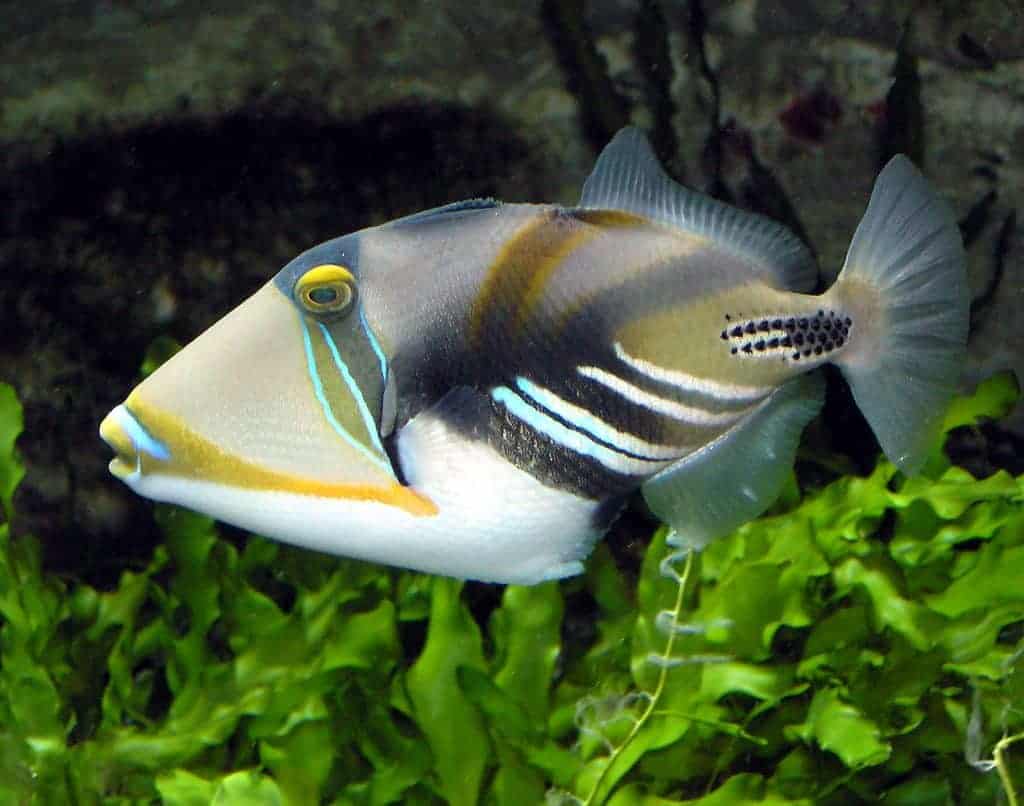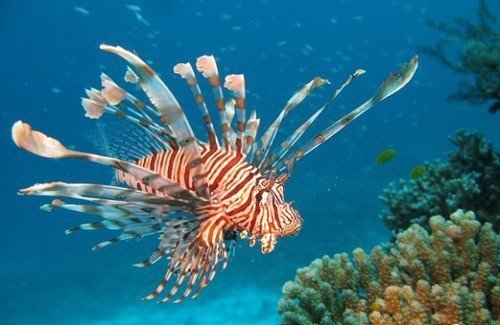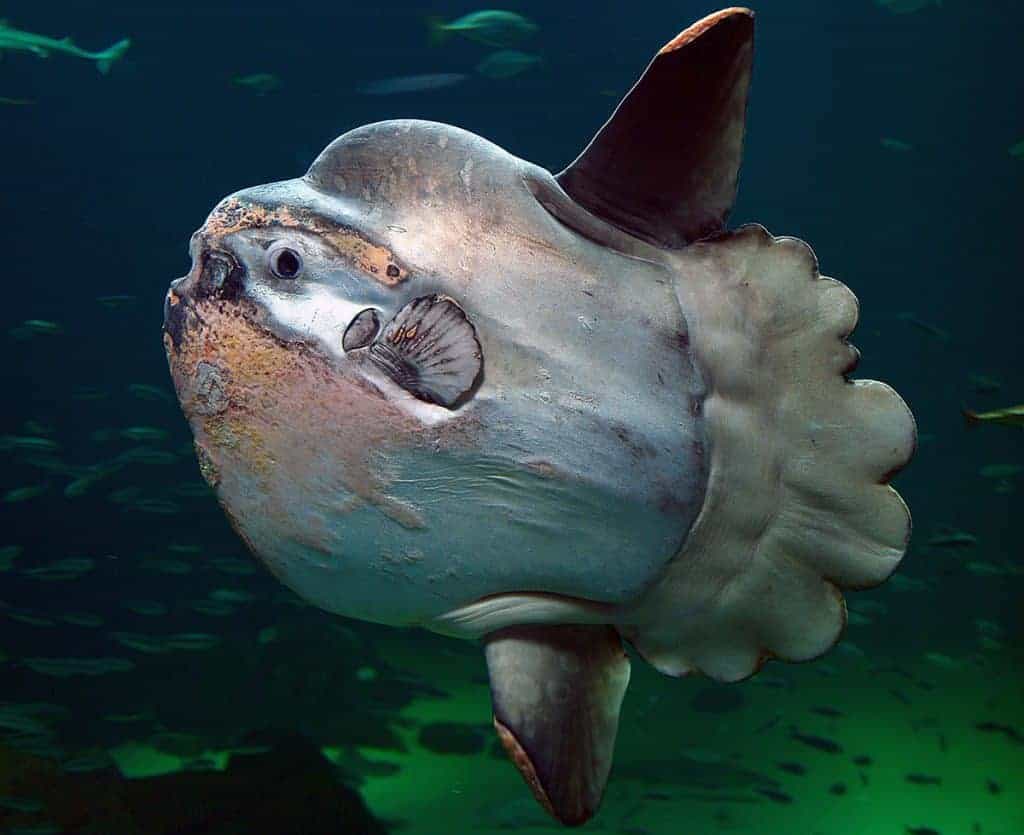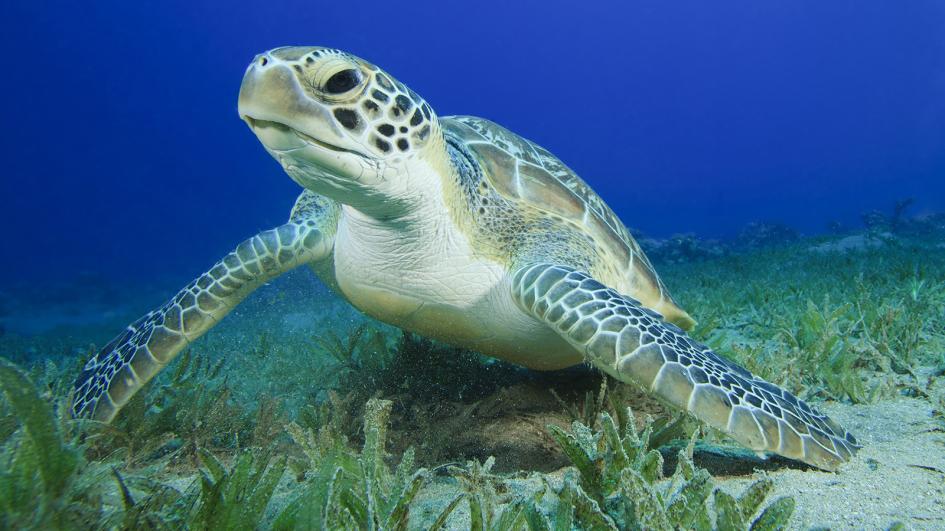
Detached from the rest of Oman by the east coast of the United Arab Emirates, the Musandam Peninsula is an exciting place to explore by boat. Scuba diving is a wonderful way of discovering the underwater beauty of this “Norway of the Middle East” because of its impressive biodiversity of marine species.
Due to its unique drop-offs and cool water upwelling, plankton thrives in the waters around Musandam which makes it a favorite feeding ground for a large variety of marine creatures. In fact, these plankton-rich waters attract more than 900 species of fish from small reef fish to giant species like whale sharks.

The triggerfish is an attractive fish commonly found in the region and they often have prominent lines and spots on their oval-shaped bodies. Despite its small mouth, the triggerfish has strong teeth and jaw built for crushing shells, hunting crabs, and feasting on sea urchins. This stunning fish may display aggressive behavior towards other fish and even divers when they venture too close to their nesting grounds. Be alert when you spot triggerfish because they can charge or bite when they feel that their eggs are threatened.

The lionfish is a showstopper in these waters with its distinctive brown or maroon, and white stripes that dominate its head and body. They are beautiful to look at but be careful not to get too close because lionfish have venomous spiky fin rays that are dangerous to humans. The best way to avoid getting stung by one is to appreciate it from a safe distance.
A fascinating swimmer found in Musandam waters is the parrot fish with its remarkable characteristic of transforming gender, coloration, and pattern. You might find it intriguing that this fish covers itself with a night “blanket” in the form of a transparent cocoon made of its own mucous from an organ on its head. According to scientists, the cocoon hides the scent of the parrot fish from nocturnal predators like moray eels and it discards the cocoon in the morning as it goes on with its normal routine.

Have you ever seen a fish that looks like half a fish? When diving in these waters, you might encounter the odd-looking ocean sunfish, also known as mola which doesn’t seem to have a back. Instead of a usual tail, the sunfish has a weird appendage called a clavus, which is formed through the connection of the fish’s dorsal and anal fin rays. Despite the absence of a strong-looking tail, the world’s largest bony fish can still leap out of the water.
Pelagics like yellowfin tuna, sailfish, marlin, longtail tuna, kingfish, and bigeye trevally also thrive in these waters because of the abundance of baitfish.
During your dive, you might also come across honeycomb rays and eagle rays. The honeycomb rays, also known as whip rays are bottom feeders that trap their prey by settling over them and flexing their disc flaps and positioning their mouth to grab hold of their victim. They normally swim away to avoid getting into harm’s way but if provoked, they can deliver a nasty sting which can be harmful to humans.
Eagle rays like the spotted eagle rays live in the warm waters of the peninsula. These graceful gliders have large, wing-like pectoral fins that help them propel in the water as well as jump out of it in a spectacular display. Although they are shy and non-aggressive creatures, eagle rays are still equipped with a venomous barb at the end of their tail that they can use if threatened so it’s advisable to keep your distance while observing them. For your own protection, never swim over the top of a stingray especially large ones because they might mistake you as a predator and whip their tails to defend themselves.

The warm waters of Musandam is also a favorite playground of sea turtles like the Green turtles. Named after the greenish color of their cartilage and fat and not their shells, these species love tropical and subtropical waters. Observing sea turtles in the wild is an amazing experience but always remember to be responsible divers. First of all, do not feed sea turtles because they might learn to associate food with humans. When that happens, they may become prone to boat strikes and poaching because they might think that humans are a source of food and would likely approach them to get some tasty morsel. Touching turtles is also strongly discouraged because it does not only alter a turtle’s behavior but it makes the turtle prone to diseases. If you want a successful encounter with a sea turtle, relax in its presence and avoid pointing your cameras immediately in front of it to lessen the chances of spooking the creature away. Try to stay still and observe the turtle quietly so that it may also relax in your presence and linger for a while. When it swims away, do not chase after it to avoid stressing the animal.
Dolphins may also be spotted in the peninsula such as the humpback dolphins (Sousa Chinensis) and the Bottlenose dolphins (Tursiops Aduncus). It’s a real treat to see these intelligent and social creatures traveling in a pod. Dolphins just like the rest of the marine creatures should be treated with respect that’s why you should not attempt to chase or touch them.
The biggest fish in the ocean, the whale shark is a seasonal visitor of this peninsula especially during the summer months between April and October. Lima Rock, one of the diving sites in Musandam is surrounded by deeper waters and feature strong upwelling currents which make it more attractive to these majestic animals.
Musandam has 15 to 40 meters visibility and year-round diving but the best time to explore this underwater oasis is from April to October. You can embark on an overnight diving trip to Musandam to maximize your diving experience in this region.
Experiences
Find the perfect escape
© 2024 NEMO DIVING CENTER
Scuba diving is an exciting and adventurous water sport that offers a chance to explore the beauty of the underwater world and its amazing marine life. The UAE, particularly Dubai, is one of the most popular destinations for scuba diving, attracting divers from all over the world. With its crystal clear waters and diverse marine life, scuba diving in Dubai offers a unique and unforgettable experience.
The cost of scuba diving in Dubai varies depending on the dive center you choose and the type of dive you opt for. On average, a single dive can cost anywhere from AED 250 to AED 550, with the average price for a single dive being around AED 350. This price usually includes all the necessary equipment, such as the dive tank, regulator, and wetsuit, as well as the services of a professional dive guide. At Nemo Diving Center, We offer a wide range of diving packages to suit every budget and experience level.
Diving in Dubai is an incredible experience, and the UAE is home to many dive sites teeming with amazing marine life including colorful soft and hard corals, sea turtles, stingrays, manta rays, moray eels, cuttlefish, octopus, nudibranchs, seahorses, and a plethora of fish species. It is also noted for its incredible dive wrecks that have become rich artificial reefs. These dive sites offer a unique and exciting diving experience, providing a chance to explore sunken ships and other structures that have become havens for marine life.
Come and explore the unique underwater world of Palm Jumeriah in Dubai and incredible dive sites in Fujairah such as Dibba Rock, Sharm Rock, Martini Rock, Snoopy Island, and more. At Nemo Diving Center, we offer dive trips to these amazing dive sites, allowing divers to discover the incredible marine life that has made the wreck its home. We also offer a wide range of other dive sites to choose from, including shallow coral reefs, deep wrecks, and drift dives, providing something for every level of diver.
In conclusion, scuba diving in Dubai offers an unforgettable experience for all levels of diver. With its clear waters, diverse marine life, and incredible dive sites, Dubai is a must-visit destination for any scuba diver. Whether you’re a beginner or an experienced diver, our team at Nemo Diving Center will ensure that you have an amazing time exploring the beauty of the underwater world.
Click one of our contacts below to chat on WhatsApp
Social Chat is free, download and try it now here!
